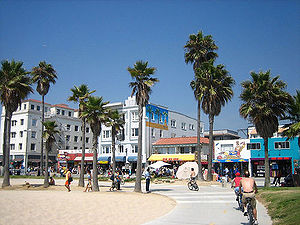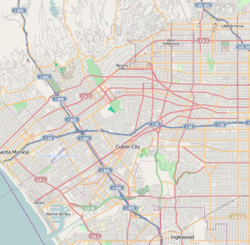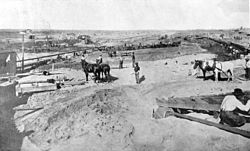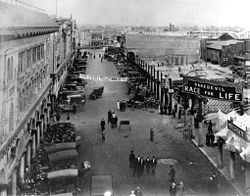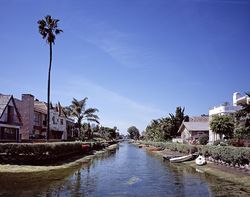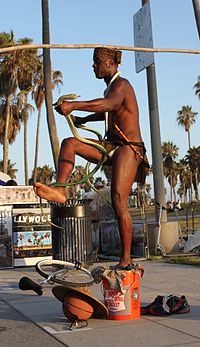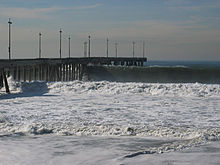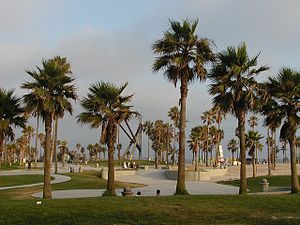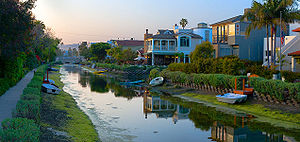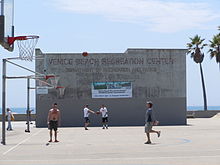- Venice, Los Angeles
-
Venice — Neighborhood of Los Angeles — Venice Beach and Boardwalk Location within Western Los Angeles Coordinates: 33°59′27″N 118°27′33″W / 33.99083°N 118.45917°W Country United States State California County County of Los Angeles City City of Los Angeles Government - City Council Bill Rosendahl - State Assembly Betsy Butler (D) - State Senate Ted Lieu (D) - U.S. House Janice Hahn - Neighborhood Council Venice Neighborhood Council Area[1] - Total 3.1 sq mi (8 km2) Population (2008)[1] - Total 40,885 - Density 12,324/sq mi (4,758.3/km2) Population changes significantly depending on areas included and recent growth. ZIP Code 90291 Area code(s) 310, 424 Venice (often referred to as Venice Beach) is a beachfront district on the Westside of Los Angeles, California, United States. It is known for its canals, beaches and circus-like Ocean Front Walk, a two-and-a-half mile pedestrian-only promenade that features performers, fortune-tellers, artists, and vendors.[2] Throughout the summer months, "the boardwalk" (as it is commonly known, despite that it contains no boards) is actively entertaining, and this tradition continues on weekends in the winter.[3] It is an important tourist attraction in Southern California,[4] and has retained its popularity in part because it is an attractive location for walking and bicycling.[3] It was home to some of Los Angeles' early beat poets and artists and has served as an important cultural center of the city.[5]
Venice is bordered by the Pacific Ocean on the southwest, by the unincorporated Marina del Rey on the southeast, by Culver City on the east, by the Los Angeles neighborhood of Mar Vista on the northeast, and by the city of Santa Monica on the north.
Contents
History
Venice of America was founded by tobacco millionaire Abbot Kinney in 1905 as a beach resort town, 14 miles (23 km) west of Los Angeles. He and his partner Francis Ryan had bought two miles (3.24 km) of oceanfront property south of Santa Monica in 1891. They built a resort town on the north end of the property called Ocean Park, which was soon annexed to Santa Monica. After Ryan died, Kinney and his new partners continued building south of Navy Street in the unincorporated territory. After the partnership dissolved in 1904, Kinney built on the marshy land on the south end of the property, intending to create a seaside resort like its namesake in Italy.
When Venice of America opened on July 4, 1905, Kinney had dug several miles of canals to drain the marshes for his residential area, built a 1,200-foot (370 m)-long pleasure pier with an auditorium, ship restaurant, and dance hall, constructed a hot salt-water plunge, and built a block-long arcaded business street with Venetian architecture. Tourists, mostly arriving on the "Red Cars" of the Pacific Electric Railway from Los Angeles and Santa Monica, then rode Venice's miniature railroad and gondolas to tour the town. But the biggest attraction was Venice's mile-long gently sloping beach. Cottages and housekeeping tents were available for rent.
The town's population increased; it annexed adjacent housing tracts, and changed its official name from Ocean Park to Venice in 1911. The population (3119 residents in 1910) soon exceeded 10,000; the town drew 50,000 to 150,000 tourists on weekends.
Attractions on the Kinney Pier became more amusement-oriented by 1910, when a Venice Scenic Railway, Aquarium, Virginia Reel, Whip, Racing Derby and other rides and game booths were added. Since the business district was allotted only three one-block-long streets, and the City Hall was more than a mile away, other competing business districts developed. Unfortunately, this created a fractious political climate. Kinney, however, governed with an iron hand and kept things in check. When he died in November 1920, Venice became harder to govern. With the amusement pier burning six weeks later in December 1920, and Prohibition (which had begun the previous January), the town's tax revenue was severely affected.
The Kinney family rebuilt their amusement pier quickly to compete with Ocean Park's Pickering Pier and the new Sunset Pier. When it opened it had two roller coasters, a new Racing Derby, a Noah's Ark, a Mill Chutes, and many other rides. By 1925 with the addition of a third coaster, a tall Dragon Slide, Fun House and Flying Circus aerial ride, it was the finest amusement pier on the West Coast. Several hundred thousand tourists visited on weekends. In 1923 Charles Lick built the Lick Pier at Navy Street in Venice, adjacent to the Ocean Park Pier at Pier Avenue in Ocean Park. Another pier was planned for Venice in 1925 at Leona Street (now Washington Street).
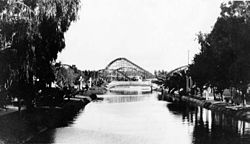 Canals with roller coaster in background, 1921.
Canals with roller coaster in background, 1921.
For the amusement of the public, Kinney hired aviators to do aerial stunts over the beach. One of them, movie aviator and Venice airport owner B. H. DeLay, implemented the first lighted airport in the United States on DeLay Field (previously known as Ince Field). He also initiated the first aerial police in the nation, after a marine rescue attempt was thwarted. DeLay also performed many of the world's first aerial stunts for motion pictures in Venice.
By 1925, Venice's politics became unmanageable. Its roads, water and sewage systems badly needed repair and expansion to keep up with its growing population. When it was proposed that Venice be annexed to Los Angeles, the board of trustees voted to hold an election. Those for annexation and those against were nearly evenly matched, but many Los Angeles residents, who moved to Venice to vote, turned the tide. Venice became part of Los Angeles in November 1925.
Los Angeles had annexed the Disneyland of its day, and proceeded to remake Venice in its own image. It was felt that the town needed more streets, not canals, and most of them were paved in 1929 after a three-year court battle led by canal residents. They wanted to close Venice's three amusement piers, but had to wait until the first of the tidelands leases expired in 1946.
In 1929, oil was discovered south of Washington Street on the Venice Peninsula. Within two years, 450 oil wells covered the area and drilling waste clogged the remaining waterways. It was a short-lived boom that provided needed income to the community, which suffered during the Great Depression. The wells produced oil into the 1970s.
Los Angeles had neglected Venice so long that, by the 1950s, it had become the "Slum by the Sea." With the exception of new police and fire stations in 1930, the city spent little on improvements after annexation. The city did not pave Trolleyway (Pacific Avenue) until 1954 when county and state funds became available. Low rents for run-down bungalows attracted predominantly European immigrants (including a substantial number of Holocaust survivors), and young counterculture artists, poets and writers. The Beat Generation hung out at the Gas House on Ocean Front Walk and at Venice West Cafe on Dudley. Police raids were frequent during that era.[6]
Venice and neighboring Santa Monica were hosts for a decade to Pacific Ocean Park (POP), an amusement and pleasure-pier built atop the old Lick Pier and Ocean Park Pier by CBS and the Los Angeles Turf Club (Santa Anita). It opened in July 1958, in Santa Monica. They kept the pier's old roller coaster, airplane ride and historic carousel, but converted its theaters and smaller pier buildings into sea-themed rides and space-themed attractions designed by Hollywood special-effects people. Visitors could travel in space on the Flight to Mars ride, tour the world in Around the World in 80 Turns, go beneath the sea in the Diving Bells or at Neptune's Kingdom, take a fantasy excursion into the Tales of the Arabian Nights on the Flying Carpet ride, visit a pirate world at Davy Jones' Locker, or visit a tropical paradise and its volcano by riding a train on Mystery Island. There were also thrill rides like the Whirlpool (rotor whose floor dropped out), the Flying Fish wild mouse coaster, an auto ride, gondola ride, double Ferris wheel, safari ride, and an area of children's rides called Fun Forest. Sea lion shows were performed at the Sea Circus.
Since attendance at the park was too low to justify winter operation, and with competition from Disneyland, Knott's Berry Farm and Marineland, it was sold after two seasons to a succession of owners, who allowed the park to deteriorate. Since Santa Monica was redeveloping the surrounding area for high-rise apartments and condos, it became difficult for patrons to reach the park, and it was forced into bankruptcy in 1967. The park suffered a series of arson fires beginning in 1970, and its was demolished by 1974. Another aging attraction in the 1960s was the Aragon Ballroom that had been the longtime home of The Lawrence Welk Show and the Spade Cooley Show, and later the Cheetah Club where rock bands such as the Doors, Blue Cheer & many other top bands performed. It burned in the 1970 fire. The district around POP in the southside of Santa Monica is known as Dogtown. It is a common misconception that Dogtown is in Venice, but the original Z-boys surfing and skateboarding shop was and is still on Main St. in Santa Monica. Venice and Santa Monica were home to pioneering skateboarders the Z-Boys, as profiled in the documentary film, Dogtown and Z-Boys. Little known is that POP pier was actually completely in Santa Monica, it started at the end of Ocean Park Blvd and extended to the line where Venice meets Santa Monica.
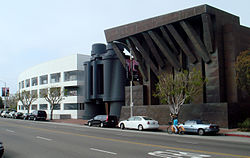 Binoculars Building (originally Chiat/Day Building), 340 Main Street. Frank Gehry, Architect. The binoculars, which house a conference room, were designed with help from Claes Oldenburg and Coosje van Bruggen
Binoculars Building (originally Chiat/Day Building), 340 Main Street. Frank Gehry, Architect. The binoculars, which house a conference room, were designed with help from Claes Oldenburg and Coosje van Bruggen
Producer Roger Corman owned a production facility, the Concorde/New Horizons Studio, on Main Street, where many of his films were shot. This facility was razed to build the Venice Art Lofts and Dogtown Station lofts.
Demographics
As of 2008, the population is estimated to be around 40,885. The median household income is $67,057, making it one the wealthiest neighborhoods in the city. The racial and ethnic composition in Venice is White (63.9%), Latino (22.2%), African American (5.6%), Asian (3.7%), and Other (4.6%).[7]
Attractions and neighborhoods
See also: Venice Canal Historic DistrictVenice is today one of the most vibrant and eclectic areas of Southern California and it continues a tradition of liberal social change involving prominent Westsiders. Venice Family Clinic is the largest free clinic in the country.
The Venice Farmers' Market that was founded in 1987 operates every Friday morning from 7-11 AM (rain or shine) in the parking lot on Venice Blvd at Venice Way offering fresh cut flowers and locally grown produce in a friendly neighborhood atmosphere (ample free parking).
Many of Venice's houses have their principal entries from pedestrian-only streets, and have house numbers on these footpaths. (Automobile access is by alleys in the rear). However, like much of Los Angeles, Venice is also well-known for traffic congestion. It lies 2 miles (3.2 km) away from the nearest freeway, and its unusually dense network of narrow streets was not planned for the demands of modern traffic. Mindful of the tourist nature of much of the district's vehicle traffic, though, its residents have successfully fought numerous attempts to extend the Marina Freeway (SR 90) into southern Venice.
Venice Beach
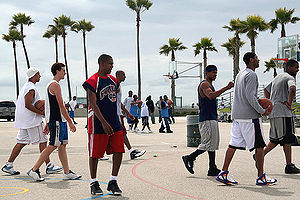 Streetballers at the Venice Beach basketball courts.
Streetballers at the Venice Beach basketball courts.
Venice Beach includes the beach, the promenade that runs parallel to the beach ("Ocean Front Walk" or just "the boardwalk"), Muscle Beach, the handball courts, the paddle tennis courts, Skate Dancing plaza, the numerous beach volleyball courts, the bike trail and the businesses on Ocean Front Walk. The basketball courts in Venice are renowned across the country for their high level of streetball; numerous NBA players developed their games or recruited on these courts.[8]
Along the southern portion of the beach, at the end of Washington Boulevard, is the Venice Fishing Pier. A 1,310-foot (400 m) concrete structure, it first opened in 1964, was closed in 1983 due to El Niño storm damage, and re-opened in the mid-1990s. On December 21, 2005, the pier again suffered damage when waves from an unusually large northern swell caused the part of the pier where the restrooms were located to fall into the ocean.
The pier remained closed until May 25, 2006, when it was re-opened after an engineering study concluded the pier was structurally sound.
The Venice Breakwater is an acclaimed local surf spot in Venice. It is located north of the Venice Pier and Lifeguard Headquarters, and south of the Santa Monica Pier. This spot is sheltered on the north by an artificial barrier, the breakwater, consisting of an extending sand bar, piping, and large rocks at its end.
This spot has differing breaks depending on swell intensity, swell direction, tide and time of the day.
Oakwood
The Oakwood neighborhood of Venice, also known as Ghost Town and the "Oakwood Pentagon", which lies inland a few blocks from the tourist areas, is one of the few historically African American areas in West Los Angeles, although Latinos have constituted the overwhelming majority of the residents. During the age of restrictive covenants that enforced racial segregation, Oakwood was set aside as a settlement area for blacks, who came by the hundreds to Venice to work in the oil fields during the 1930s and 1940s. After the construction of the San Diego Freeway passed through predominantly Mexican and immigrant communities, they moved further west and into Oakwood. Whites moved in or around Oakwood during the 1980s and 1990s.
The Venice Shoreline Crips and the Latino Venice 13 gang, which are under a shaky truce, continue to remain active in Venice. By 2002, numbers of gang members in Oakwood were reduced due to gentrification and increased police presence. According to a Los Angeles City Beat article, by 2003, many Los Angeles Westside gang members resettled in the city of Inglewood.[9]
Near the end of the 20th century, gentrification has greatly altered Oakwood. Although still a primarily Latino and African-American neighborhood, the neighborhood is in flux. According to Los Angeles City Beat,[10] "In Venice, the transformation is....obvious. Homes are fetching sometimes more than $1 million, and homies are being displaced every day." Author John Brodie challenges the idea of gentrification causing change and commented "...the gunplay of the Shoreline Crips and the V-13 is as much a part of life in Venice as pit bulls playing with blond Labs at the local dog park."[11] Xinachtli, a Latino student group from Venice High School and subset of MEChA, refers to Oakwood as one of last beachside communities of color in California. Chicanos and Latinos of any race make up over 50% of Venice High School's student body.[12]
East Venice
East Venice is a racially and ethnically mixed, residential neighborhood of Venice that is separated from Oakwood and Milwood (the area south of Oakwood) by Lincoln Boulevard, extending east to the border with Mar Vista, near Venice High School. Aside from the commercial strip on Lincoln (including the Venice Boys and Girls Club and the Venice United Methodist Church), the area almost entirely consists of small homes and apartments as well as Penmar Park and (bordering Santa Monica) Penmar Golf Course. The existing population (primarily composed of Caucasians, Hispanics, and Asians, with small numbers of other groups) is being supplemented by new arrivals who have moved in with gentrification.
A housing project, Lincoln Place, was built nearby by the Housing Authority of the City of Los Angeles to accommodate GI's returning from the war and in need of affordable housing. It later came to house working class families. Lincoln Place is currently in the midst of an extensive legal battle between past and present tenants and the owner, AIMCO. The developer, which acquired the property in 2003, plans to demolish it and build a mixed-use condominium and retail structure on the site. Only 13 tenants remain, all of them elderly or disabled.
As of 2010 the housing developer AIMCO has settled with tenants and agreed to reopened the project and return scores of evicted residents to their homes and add hundreds of below-market-rate units to the Venice area.[13]
Notable residents and businesses
Venice has always been known as a hangout for the creative and the artistic. In the 1950s and 60s, Venice became a center for the Beat generation. There was an explosion of poetry and art. Major participants included Stuart Perkoff, John Thomas, Frank T. Rios, Tony Scibella, Lawrence Lipton, John Haag, Saul White, Robert Farrington, Philomene Long and Tom Sewell.[6] In the 1970s, prominent performance artist Chris Burden created some of his early, groundbreaking, work in Venice, such as Trans-fixed.[14]
Prominent residents of Venice include Youtube sensation Shay Butler, artist Greg Colson, writer Russell T Davies, singer Brandon Boyd, actresses Anna Paquin, Kate Beckinsale, Valeria Andrews, Lana Clarkson and Anjelica Huston, actors Tim Robbins, Tom Conway (brother of actor George Sanders), lived here in the 1960s, Nicolas Cage, Christian Bale, Stephen Moyer, Chaney Kley, Tim Meadows, Robert Hegyes, Mark Valley, Michael T. Weiss, Fairuza Balk, Taylor Negron, artist Martha Alf, and musicians Perry Farrell, Evidence of Dilated Peoples, Saint John of Saint John and the Revelations, Joshua Kadison, John Lydon (who owns a sizeable amount of rental property in Venice), Ozzy Lusth, and Jud "Fabio" Birza from Survivor, architect Lawrence Scarpa, John Frusciante, ex-guitarist of the Red Hot Chili Peppers, Tommy Mars of the Frank Zappa band, Fiona Apple and Mike Muir and most of his Suicidal Tendencies bandmates. Photographer Lauren Greenfield has lived in Venice since 1972. R&B singer Teena Marie spent her childhood and teenage years in Venice, performing along the boardwalk before her big break with Motown.
Actress Lindsay Lohan lives in the Windward Circle area (next to DJ Samantha Ronson) upon her recent release from the Betty Ford clinic. Actress Julia Roberts owned a house for ten years on one of the walk streets (which was recently sold to actor Tim Robbins) but has primarily resided in Malibu since 2009. Actor Robert Downey, Jr. kept an apartment on the boardwalk during the 1990s and currently owns a building on Abbot Kinney Boulevard. Harding Avenue is also where The Lennon Sisters of Lawrence Welk fame grew up. Jim Morrison lived in Venice for two years where he met Ray Manzarek to form the nucleus of The Doors. Arnold Schwarzenegger's acting career began after becoming a regular bodybuilder at Venice's famous Gold's Gym, whose present facility claims to be "The Mecca of Bodybuilding." Restaurateur Wolfgang Puck has owned and operated noted eateries in the area since the 1990s. Other notables include actors Viggo Mortensen, Rutger Hauer, Bryan Callen, Paul Giamatti, Camryn Manheim, Maria Bello and Elijah Wood, and film directors Vadim Perelman, Henry Jaglom and Paul Mazursky, and Extreme Makeover: Home Edition Host Ty Pennington. For many years, pro wrestlers Hulk Hogan and Sting were announced as residing in Venice Beach as well. Standup comedians, such as Nick Swardson, Jim Jeffries, Eddie Ifft, Paul Provenza, George Carlin and Zach Galifianakis and street performers have proliferated in Venice, Wavy Gravy and Swami X being two of the more recent hippie busker alumni. Federal civil rights lawyer Stephen Yagman lives there. Political contributions have been sent from homes in Venice from the actor Dennis Hopper and Simpsons creator Matt Groening. South Park co-creator Matt Stone lives in Venice as well.[15] Harry Perry, the famous street entertainer, is one of the boardwalk's key performers. Photographer Helen K. Garber maintains a studio on Ocean Front Walk. Graffiti/Street Artist and painter Jean-Michel Basquiat lived in Venice in the 80's. Immature, an R&B group from the 1990s, used to perform on the boardwalk prior to becoming famous.
TNA professional wrestlers Hulk Hogan and Sting are billed as being from Venice Beach; they actually hail from Tampa, Florida and Omaha, Nebraska respectively.
Venice is today a vibrant area of Southern California and it continues a tradition of progressive social change involving prominent Westsiders. The Venice Family Clinic is the largest free clinic in the country. The Venice Community Housing Corporation, a nonprofit dedicated to preserving the economic, racial and social diversity of Venice and the surrounding area, provides affordable housing, economic and community development opportunities and needed social services to low income residents. Women in Recovery, Inc., a non-profit organization offering a live-in, 12-step program of rehabilitation for women in need, was founded by a longtime resident of Venice, Sister Ada Geraghty. Geraghty and her organization on Coeur D'Alene Avenue annually honor those who've made a difference in helping women overcome substance abuse problems. The 2006 honoree for Women in Recovery was Christopher Lawford; past honorees have included Jamie Lee Curtis, Angela Lansbury, and Anthony Hopkins.
Government and infrastructure
Local government
The Los Angeles Fire Department operates Station 63, which serves Venice.
Los Angeles Police Department serves the area through the Pacific Community Police Station at 12312 Culver Boulevard, Los Angeles, CA 90066, and a beach sub-station at 1530 W. Ocean Front Walk, Venice, CA 90921.[16]
Los Angeles County Lifeguards
Venice Beach is the headquarters of the Lifeguard Division of the Los Angeles County Fire Department. It is located at 2300 Ocean Front Walk. It is the nation's largest ocean lifeguard organization with over 200 full-time and 700 part-time or seasonal lifeguards. The headquarter building used to be the City of Los Angeles Lifeguard Headquarters until Los Angeles City and Santa Monica Lifeguards were merged into the County in 1975. The department is commonly referred to by Angelenos as Baywatch Lifeguards.
The Los Angeles County Lifeguards safeguard 31 miles (50 km) of beach and 70 miles (110 km) of coastline, from San Pedro in the south, to Malibu in the north. Lifeguards also provide Paramedic and rescue boat services to Catalina Island, with operations out of Avalon and the Isthmus.
Lifeguard Division employs 120 full-time and 600 seasonal lifeguards, operating out of three sectional headquarters, Hermosa, Santa Monica, and Zuma beach. Each of these headquarters staffs a 24-hour EMT-D response unit and are part of the 911 system. In addition to providing for beach safety, Los Angeles County Lifeguards have specialized training for Baywatch rescue boat operations, underwater rescue and recovery, swiftwater rescue, cliff rescue, marine mammal rescue and marine firefighting.
County, state and federal representation
The Los Angeles County Department of Health Services SPA 5 West Area Health Office serves Venice.[17]
The United States Postal Service operates the Venice Post Office at 1601 Main Street and the Venice Carrier Annex at 313 Grand Boulevard.[18][19]
Education
Primary and secondary schools
Public schools
Venice is served by many Los Angeles Unified School District schools. The area is within Board District 4.[20] As of 2009 Steve Zimmer represents the district.[21]
The neighborhood is served by Coeur d'Alene Avenue Elementary School, Westminster Avenue Elementary School, Short Avenue Elementary School, and Broadway Elementary. Students go on to Mark Twain Middle School. High school students attend Venice High School, which is actually in Venice rather than, as many believe, in the adjacent neighborhood of Mar Vista.
Private schools
Saint Mark Elementary School is a private school in the area.
Public libraries
Los Angeles Public Library operates the Venice - Abbot Kinney Memorial Branch.[22]
Parks and recreation
The Venice Beach Recreation Center nominally located at 1800 Ocean Front Walk, comprises a number of facilities sprawling between Ocean Front Walk and the bike path, Horizon Ave. to the north and N.Venice Blvd. to the south. The installation has basketball courts (unlighted/outdoor), several children play areas w. gymnastics apparatus, handball courts (unlighted), tennis courts (unlighted), volleyball courts (unlighted). At the south end of the area is the famous muscle beach outdoor gymnasium. In March 2009 the city opened a sophisticated M $2 skate park on the sand towards the north. While not technically part of the park the Graffiti Walls on the beach side of the bike path in the same vicinity.[23]
The Oakwood Recreation Center is located at 767 California Ave. The center, which also acts as a Los Angeles Police Department stop-in center, includes an auditorium, an unlighted baseball diamond, lighted indoor basketball courts, unlighted outdoor basketball courts, a children's play area, a community room, a lighted American football field, an indoor gymnasium without weights, picnic tables, and an unlighted soccer (football) field.[24]
The Westminster Off-Leash Dog Park is in Venice.[25]
Venice in the media
Dozens of movies and hundreds of television shows have used locations in Venice, including its beach, its pleasure piers, the canals and colonnades, the boardwalk, the high school, even a particular hamburger stand.[26] Various Venice venues are visible in this list of selected media:
Film
- 1914- Kid Auto Races at Venice (Charlie Chaplin)
- 1920- Number, Please? (Harold Lloyd) Number, Please? at the Internet Movie Database
- 1921- The High Sign (Buster Keaton) The High 'Sign' at the Internet Movie Database
- 1923- The Balloonatic (Buster Keaton) The Balloonatic at the Internet Movie Database
- 1927- Sugar Daddies (Laurel and Hardy)
- 1928- The Circus (Charlie Chaplin)
- 1928- The Cameraman (Buster Keaton) The Cameraman at the Internet Movie Database
- 1933- Fish Hooky - Our Gang Comedies (Little Rascals) Fish Hooky at the Internet Movie Database
- 1935- Dante's Inferno (Spencer Tracy, Claire Trevor)
- 1950- Quicksand, (Mickey Rooney, Jeanne Cagney, Peter Lorre)
- 1958- Touch of Evil (Charlton Heston, Janet Leigh, Orson Welles director) - Venice is used for lonely Mexican town.
- 1961- Night Tide (Dennis Hopper, Linda Lawson, written and directed by Curtis Harrington) - Shot entirely in Venice and shows the deteriorated nature of the area in the 1950s.
- 1965- Inside Daisy Clover (Robert Redford, Natalie Wood, Christopher Plummer)
- 1966- The Wild Angels (Peter Fonda, Nancy Sinatra, Bruce Dern)
- 1966- Blood Bath (William Campbell, Sid Haig)
- 1968- I Love You, Alice B. Toklas (Peter Sellers) I Love You, Alice B. Toklas! at the Internet Movie Database
- 1971- The Outside Man (Ann-Margret)
- 1972- Cisco Pike (Kris Kristofferson, Gene Hackman, Karen Black) - Kristofferson, playing a small-time drug dealer living on Ocean Front walk, gets involved with a crooked cop, played by Hackman. Climax on the beach.
- 1976- Mother, Jugs & Speed (Bill Cosby, Raquel Welch, Harvey Keitel) Mother, Jugs and Speed! at the Internet Movie Database Dark comedy about the Fishbine Ambulance Company, dealing with social issues of the day, great cameos of Venice, located at 425 Rose Ave., now the Venice Ranch Market.
- 1978- Grease (John Travolta, Olivia Newton-John) - Venice High is the setting for Rydell High.
- 1979- Roller Boogie (Linda Blair)
- 1980- The Jazz Singer (Neil Diamond)
- 1980- Xanadu (Olivia Newton-John)
- 1983- Breathless (Richard Gere)
- 1984- A Nightmare on Elm Street I (1984 film)| Heather Langenkamp, Johnny Depp, Robert Englund, Jsu Garcia, directed by (Wes Craven)
- 1984- Breakin'
- 1984- Weekend Pass
- 1985- The Falcon and the Snowman (Sean Penn, Timothy Hutton), Fletch (Chevy Chase)
- 1986- Cobra - Sylvester Stallones character lives off the boardwalk
- 1986- Thrashin' - The skaters visit Venice Beach throughout the movie.
- 1988- Colors (Sean Penn, Robert Duvall) - The scene with C.R.A.S.H. officers arresting High Top.
- 1991- The Doors (Val Kilmer, directed by Oliver Stone)
- 1991- L.A. Story (Steve Martin, Sarah Jessica Parker)
- 1992- White Men Can't Jump (Wesley Snipes, Woody Harrelson) - The pickup games were set at the public courts, but filmed in a doubled location in a Venice beachside parking lot.
- 1993- Falling Down (Michael Douglas) - Final scenes are on Venice Pier, closed at the time but since repaired.
- 1993- GIFT (Perry Farrell)
- 1993- Point of No Return (Bridget Fonda) - Lead character moves into an apartment on Venice Beach.
- 1993- "Extreme Justice," produced by Wolf Schmidt, with Lou Diamond Phillips, Yaphet Koto, and Scott Glenn, about the LAPD's notorious death squad, the S.I.S. (Special Investigations Section).
- 1994- Clean Slate - Maurice Pogue lives in a (fictitious) apartment on the Boardwalk; noted Venice muralist Rip Cronk also appears.
- 1994- Monkey Trouble
- 1994- Speed (Keanu Reeves) - The first bus explosion occurs in Venice (in front of The Firehouse at Main and Rose), as referenced later on in the film.
- 1995- Strange Days
- 1995- The Net (Sandra Bullock)
- 1996- Romeo + Juliet - set in a fictional "Verona Beach", very similar to Venice Beach.
- 1997- Romy and Michele's High School Reunion - Romy (Mira Sorvino) and Michele (Lisa Kudrow) live in a Venice boardwalk apartment, whence they journey back to their hometown.
- 1998- American History X
- 2000- Bounce - Buddy (Ben Affleck) stays at an Ocean Front Walk property overlooking volleyball courts.
- 2001- Dogtown and Z-Boys
- 2003- Hollywood Homicide - Harrison Ford and Josh Hartnett chase Kurupt through the neighborhoods of Venice.
- 2003- Thirteen
- 2004- 2Pac: Resurrection - 2pac does an interview with MTV's Tabitha Soren on the Venice boardwalk.
- 2004- Million Dollar Baby - The lead character works at the On The Waterfront Cafe, runs along the water on the beach and the Venice Pier can be seen in two scenes. Also, the church Clint Eastwood's character attends is St. Mark Catholic Church in Venice.
- 2005- Monster-in-Law opening scene takes place in Venice and parts of the movie also.
- 2005- Kiss Kiss Bang Bang House of one of the main characters.
- 2005- Lords of Dogtown
- 2006- Tenacious D in The Pick of Destiny
- 2007- Because I Said So
- 2007- Smiley Face
- 2007- Wild Hogs
- 2008- Southland Tales
- 2008- Drillbit Taylor
- 2008- Role Models
- 2009- I Love You, Man
- 2009- Funny People
- 2010- StarStruck - Sterling Knight's character goes on a beachwalk with his love interest, Danielle Campbell's character at Venice Beach.
- 2010- Valentine's Day - Ashton Kutcher's character lives in a house overlooking the Venice Canal.
See also
- List of California public officials charged with crimes, Venice
- J.C. Barthel, Venice postmaster and commissioner of supplies, 1920s. President of the Chamber of Commerce.
- Charles Winchester Breedlove, Los Angeles City Council member, 1933–45, supported legalized tango games
- Karl L. Rundberg, Los Angeles City Council member (1957–65), opposed Venice beatniks
References
- ^ a b "Los Angeles Times Neighborhood Project". http://projects.latimes.com/mapping-la/neighborhoods/neighborhood/westlake/. Retrieved 2010-04-11.
- ^ Venice Beach - Great Public Spaces | Project for Public Spaces (PPS)
- ^ a b Venice Beach, California
- ^ "History of Venice Beach". Los Angeles.com. http://www.losangeles.com/venice-beach/history.html.
- ^ Venice History, Part 3
- ^ a b Maynard, John Arthur (1993). Venice West: The Beat Generation in Southern California. Rutgers University Press. ISBN 0813519659.
- ^ "Venice" entry on the Los Angeles Times "Mapping L.A." website
- ^ "Court profile of Venice Beach basketball court". courtsoftheworld.com. http://www.courtsoftheworld.com/courts/184:United-States/12:Los-Angeles-CA/1:Venice-Beach.
- ^ Los Angeles CityBeat - Gangster's Paradise Lost[dead link]
- ^ http://www.lacitybeat.com/article.php?id=362&IssueNum=22
- ^ Venice in Magazines etc
- ^ http://www.sioc.ucla.edu/main.asp?nav=projects&nav=XINACHTLI
- ^ http://articles.latimes.com/2010/may/26/local/la-me-0526-lincoln-place-20100526 articles.latimes.com
- ^ "Chris Burden at Virtual Venice". http://www.virtualvenice.info/visual/burden.htm. Retrieved 6 August 2011.
- ^ Matt Stone interview at Rolling Stone
- ^ Pacific Community Police Station - official website of THE LOS ANGELES POLICE DEPARTMENT
- ^ "About Us." Los Angeles County Department of Health Services. Retrieved on March 18, 2010.
- ^ "Post Office Location - VENICE." United States Postal Service. Retrieved on December 6, 2008.
- ^ "Post Office Location - VENICE CARRIER ANNEX." United States Postal Service. Retrieved on December 6, 2008.
- ^ Board District 4 Map. Los Angeles Unified School District. Retrieved on November 24, 2008.
- ^ "Board Members." Los Angeles Unified School District. Retrieved on September 16, 2009.
- ^ "Venice - Abbot Kinney Memorial Branch." Los Angeles Public Library. Retrieved on March 18, 2010.
- ^ "Venice Beach Recreation Center." City of Los Angeles. Retrieved on March 22, 2010.
- ^ "[1]." City of Los Angeles. Retrieved on Januarz 22, 2011.
- ^ Home page." Westminster Off-Leash Dog Park. Retrieved on March 22, 2010.
- ^ Venice - Movie Making and TV shows at Venice Beach
Further reading
- Maynard, John Arthur. Venice West: The Beat Generation in Southern California. Rutgers University Press, 1993. ISBN 0813519659.
- Stanton, Jeffrey. Venice California: Coney Island of the Pacific Donahue Publishing 2005, ISBN 0-9619849-3-7 . Comprehensive history of the beach town and its amusement piers including Pacific Ocean Park with 367 historic photographs.
External links
- Free Venice Beachhead (Longest running free newspaper in Venice Beach!)
- Venice Departures KCET - Online documentary series by public broadcaster KCET mapping L.A. neighborhoods
- Venice California travel guide from Wikitravel
- Venice Beach 360° Webcam - From the Los Angeles County Lifeguard headquarters
- Venice California History Site (Articles, Maps, Timelines, Historic Photos)
- Virtual Venice
Coordinates: 33°59′27″N 118°27′33″W / 33.99083°N 118.45917°W

Santa Monica, California Mar Vista, Los Angeles 

 Venice, Los Angeles
Venice, Los Angeles 
Del Rey, Los Angeles 
Marina del Rey, California Santa Monica Bay Playa del Rey Westchester, Los Angeles City of Los Angeles Topics History • Transportation • Culture • Landmarks • Historic sites • Skyscrapers • Demographics • Crime • Sports • Media • Music • Notable people • Lists
Government Flag • Mayors • City Council • Other elected officials • Airport • DWP • Fire Department • Police • Public schools • Libraries • Port • TransportationRegions Downtown • Eastside/Northeast • Harbor Area • Greater Hollywood • Westlake & Silver Lake/Los Feliz • San Fernando and Crescenta Valleys • South Los Angeles • Westside • WilshireWestside region, Los Angeles Districts and
neighborhoodsBel Air · Benedict Canyon · Beverly Crest · Beverly Glen · Beverly Hills Post Office · Beverlywood · Brentwood · Brentwood Circle · Brentwood Glen · Century City · Cheviot Hills · Crestview · Del Rey · East Gate Bel Air · Holmby Hills · Kenter Canyon · Mandeville Canyon · Marina Peninsula · Mar Vista · Palisades Highlands · Pacific Palisades · Palms · Playa del Rey · Playa Vista · Rancho Park · Rustic Canyon · Sawtelle · South Robertson · Venice · West Los Angeles · Westchester · Westdale · Westside Village · Westwood
Points of
interestSee also Downtown · Eastside/Northeast · Harbor Area · Greater Hollywood · Westlake & Silver Lake/Los Feliz · San Fernando and Crescenta Valleys · South Los Angeles · Westside · Wilshire Categories:- Populated places established in 1822
- Beaches of Southern California
- Neighborhoods in Los Angeles, California
- Parks in Los Angeles, California
- Populated coastal places in California
- Hollywood history and culture
- Busking venues
- Landmarks in Los Angeles, California
- Seaside resorts in California
- Defunct amusement parks in California
Wikimedia Foundation. 2010.

